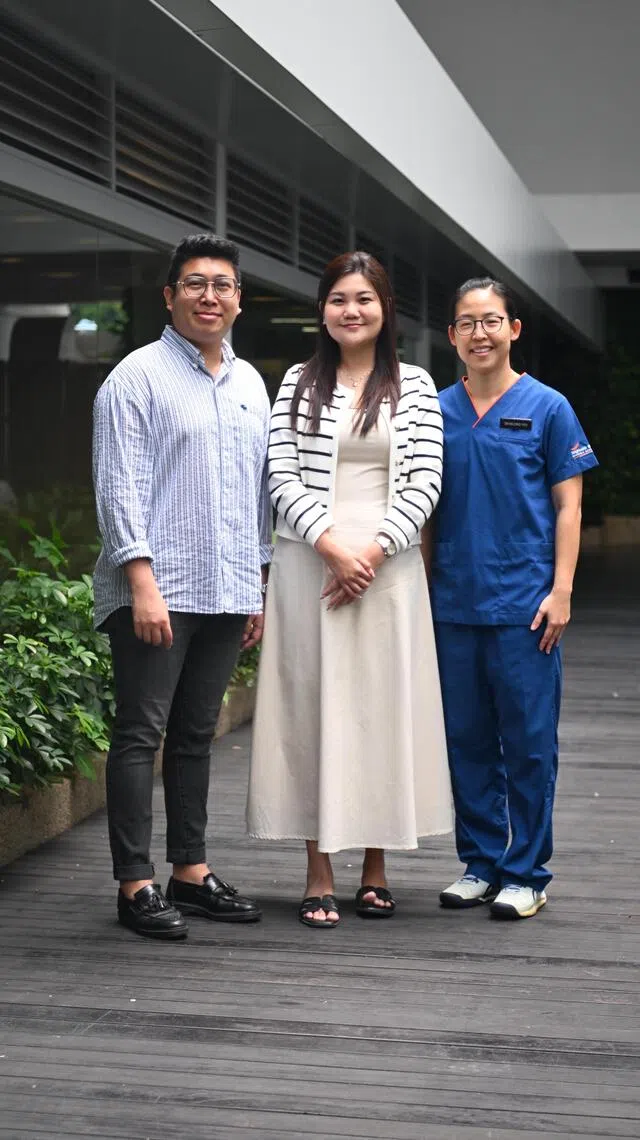Medical Mysteries
Her rare condition means eating protein risks build-up of toxic ammonia levels in her blood
Medical Mysteries is a series that spotlights rare diseases or unusual conditions.
Sign up now: Get ST's newsletters delivered to your inbox

Ms Rachelle Yeo (right), who was diagnosed with ornithine transcarbamylase deficiency, and her fiance Luis Teo are due to get married in 2026.
ST PHOTO: AZMI ATHNI
Follow topic:
- Rachelle Yeo has Ornithine Transcarbamylase (OTC) deficiency, a rare genetic disorder where her body cannot process protein, causing toxic ammonia build-up.
- Diagnosed at 18 months, Rachelle manages OTC through a restricted protein diet and medication, carefully monitored by her mother and doctors at KKH.
- Pregnancy poses risk for OTC patients due to heightened catabolic states; Rachelle will require intensive monitoring during pregnancy and delivery.
AI generated
SINGAPORE – Growing up, insurance agent Rachelle Yeo was often told by her mother that she was “different – not special”.
“I went to mainstream schools, did my homework and hung out with friends like any other school-going child. I even took part in sports,” said Ms Yeo, 29.
The only thing different was that she could not indulge in the occasional rib-eye steak dinner, fried chicken or even a good scrambled egg breakfast.
Ms Yeo has a rare hereditary metabolic disorder called ornithine transcarbamylase (OTC) deficiency, where the body cannot remove ammonia, produced when protein is broken down, from the body.
“As a baby, I was feeding poorly and vomiting often. I also had fever and seizures. The doctor at the first hospital where my mother took me told her that I had fits, prescribed some medication and then sent us home,” she said.
“But I guess it was a mother’s intuition because she knew it was not so simple. She did not medicate me but instead took me to KKH (KK Women’s and Children’s Hospital) for further tests. That was where she met Dr Teo Siak Hong. He was then researching into this kind of condition in babies.”
Dr Teo, who has since retired from the hospital, diagnosed Ms Yeo with OTC when she was 18 months old.
Part of a class of genetic diseases called urea cycle disorders, OTC deficiency impairs the body’s urea cycle – the process by which the body eliminates nitrogen waste, particularly ammonia, as urea in urine. High levels of ammonia in the blood are toxic.
As there is no cure, OTC deficiency treatment and management are aimed at preventing excessive ammonia from being formed or removing excessive ammonia.
Those with the deficiency have to limit the amount of protein they consume, while medication such as sodium benzoate can stimulate the removal of nitrogen from the body.
Ms Yeo follows a protein-restricted diet to limit the ammonia build-up, while ensuring she still gets enough protein for essential bodily functions and growth.
Sticking to a specialised diet helps to balance protein intake and this is adjusted during periods of illness or increased ammonia levels.
When she was younger, her mother had to carefully measure her intake of protein.
“It used to be only 2g a day when I was very young. My diet was supplemented with protein-free foods containing essential amino acids. I would take food to school and never ate out,” she said.

Dr Mildrid Yeo (right), with Ms Rachelle Yeo and Ms Yeo’s fiance Mr Luis Teo (left).
ST PHOTO: AZMI ATHNI
Males with OTC deficiency usually have it worse.
Dr Mildrid Yeo, a consultant with the Department of Genetics at KKH, said the condition is linked to the X chromosome.
Males have only one X chromosome, so this means they are more likely to be severely affected from birth if they inherit the faulty gene.
“Females with two X chromosomes are either carriers or develop less severe, later-onset symptoms of OTC,” she added.
OTC is considered very rare, with an estimated global prevalence of around one in 50,000 to one in 80,000 in newborns.
Like many other genetic metabolic disorders, the symptoms and complications associated with the condition include lethargy, developmental delays, seizures and long-term complications such as intellectual disability.
OTC is not in the list of 40 metabolic and heritable diseases under the National Expanded Newborn Screening (Nens) programme.
“OTC deficiency is not included in most newborn screening programmes because current tests are not sensitive or specific enough,” Dr Yeo said.
Ms Yeo’s condition did not stop her from representing her secondary school in swimming, to the chagrin of her doctor and her mother.
As an athlete, she said, “I needed protein to build muscles, and this worried my mother”.
An increase in protein intake could result in brain swelling and death.
Since Ms Yeo could not consume protein, which provides the building blocks for muscle repair, her recovery was slower.
“I usually suffered post-competition pain longer than any other athlete,” she said.
As she prepares for marriage in 2026 and to start a family, Ms Yeo will need to be monitored closely, “especially when she is in the family way”, her doctor said.
Dr Yeo said expectant mothers with OTC deficiency are at high risk throughout pregnancy and after delivery, because the body may break down carbohydrates, fat and, if necessary, muscle tissue more rapidly to meet energy demands if their energy intake is insufficient.
“But the management focus varies across trimesters, especially during labour and delivery when the metabolic stress can push up the level of ammonia in the body. We will have to monitor her metabolic status intensively,” Dr Yeo added.
Still, Ms Yeo says: “I am happy being able to live a day at a time. Now being able to find love and going into the second stage of my life is indeed a great blessing.”


